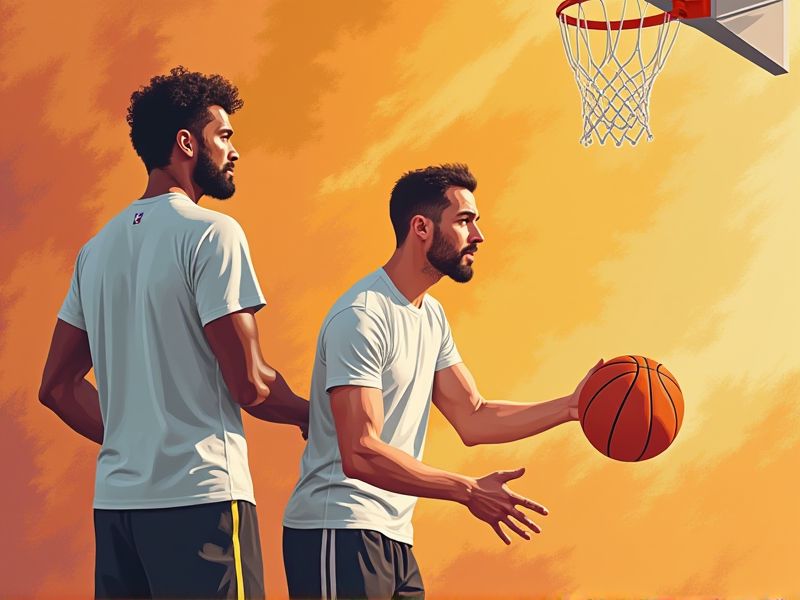
To improve at basketball, kids can learn from **Kobe Bryant's** emphasis on discipline and perseverance: "Through basketball, I learned discipline, perseverance, teamwork, failure, success. These are lessons that can be applied to any field," he noted. Practicing regularly and focusing on teamwork are key elements, as highlighted by coaches like **John Wooden**, who stressed the importance of discipline and giving 100% effort all the time. By adopting these principles, kids can develop not only their basketball skills but also valuable life skills such as teamwork and resilience.
How to Be Better at Basketball Kids Home
Consistent dribbling drills
Establish a daily routine featuring structured dribbling drills that enhance muscle memory and ball control. Focusing on varied exercises like crossover, behind-the-back, and between-the-legs drills builds hand-eye coordination and reaction speed. Consistent practice at home reinforces strong foundational skills, leading to improved agility and overall court performance. As players progress through these exercises, their enhanced dribbling proficiency directly boosts confidence and effectiveness during competitive games.
Accurate shooting form
Focus on alignment by ensuring feet, knees, and shoulders remain squared toward the basket to build muscle memory and consistency in shot tracking. Emphasize a smooth follow-through with your wrist snapping at the end of each shot, as this generates backspin and increases accuracy. Practice shooting from various distances and angles in a controlled home setting to develop versatility and adaptability. Consistently using a proper shooting routine improves overall performance by reinforcing accurate form and technique with repeatable success.
Effective passing techniques
Focus on mastering the fundamentals by practicing chest passes against a wall, which hones precision and builds muscle memory. Repeating passing drills at home boosts coordination and reinforces the mechanics needed for effective teamwork. Adjusting body angles and using both hands during practice influences accuracy and prepares kids for in-game situations. Consistent repetition at home strengthens technique and instills the discipline necessary for high-level performance on the court.
Robust defensive stances
Setting up a solid defensive stance involves keeping your feet shoulder-width apart and bending your knees to maintain balance during quick lateral movements. Kids can practice this at home by marking a small area and repeatedly shifting their weight side-to-side, simulating an opponent's movement. Regular drills that focus on quick changes in direction reinforce proper form, enhancing both stability and reaction time. This foundational skill not only helps in guarding opponents but also builds overall agility and strength on the court.
Agile footwork routines
Consistent agile footwork routines strengthen balance and coordination, laying the foundation for improved basketball performance. Exercises like ladder drills and lateral shuffles help boost speed and quickness, enabling kids to maneuver better on the court. Incorporating interval training into footwork drills increases stamina and reinforces precise movements under pressure. Regular practice at home, even for short bursts, can yield significant enhancements in both defense and offense.
Intensive conditioning workouts
Intensive conditioning workouts at home can enhance endurance while boosting speed and agility, key components of a successful basketball game. High-intensity interval training (HIIT) routines, including sprint intervals and circuit drills, dramatically improve cardiovascular fitness and on-court stamina. Incorporating bodyweight exercises like push-ups, squats, and lunges builds strength, necessary for maintaining balance and reacting quickly during rapid transitions. Regular, well-structured conditioning sessions instill discipline and resilience, directly elevating performance in competitive game situations.
Rebounding strategies practice
Start by setting up a designated area to practice rebounds, such as using a wall to simulate a live rebound scenario. Drill your timing by tossing the ball against the wall and jumping for the catch, which can systematically upgrade your reaction speed and vertical leap. Integrate exercises like lunges and squats to enhance your lower-body strength, essential for effective boxing-out and securing rebounds. Commit to a consistent practice routine at home that emphasizes both positioning and power, as data shows regular training can improve rebound success rates significantly.
Game scenario simulations
Simulating game scenarios at home can build situational awareness and decision-making skills by recreating in-game pressure during practice drills. Creating specific drills that mimic defensive pressure or fast break opportunities helps kids learn to adjust their speed, dribbling, and shooting under realistic conditions. Regularly organizing small-sided games with family members or teammates can improve communication and teamwork, as well as reinforce understanding of offensive sets and defensive structures. Using these targeted practice sessions makes the transition to organized, competitive play smoother by reinforcing positive habits and boosting overall basketball IQ.
Focus-enhancing mindfulness
Integrating mindfulness into home practice helps kids quiet internal distractions and maintain concentration during drills. Daily mindfulness exercises like deep breathing or simple meditation before shooting hoops have been shown to boost focus and reduce game-day anxiety. This calm state of mind reinforces muscle memory, allowing young athletes to execute complex moves more effectively. A regular schedule that combines mindfulness with physical practice cultivates both mental resilience and improved basketball skills.
Progressive skill challenges
Set up a routine that starts with basic drills and gradually introduces more complex challenges to develop key skills such as dribbling, shooting, and passing. Begin with simple tasks like dribbling in place or shooting from short distances, then increase the difficulty by adding movement, time limits, or multitasking elements. Incorporate progress tracking to monitor performance over time; using data like successful shots or timed completion can boost confidence and highlight improvement areas. Adapt challenges based on individual progress, ensuring each new level pushes skills gradually while keeping the practice engaging and fun.
Summary
Consistent dribbling drills at home build foundational ball control, enabling kids to navigate competitive play with increased agility and precision. Refining an accurate shooting form through repetition ensures improved scoring consistency and heightened confidence on the court. Practicing effective passing techniques not only enhances individual skills but also fosters better team dynamics by promoting efficient ball movement. Collectively, these targeted practices contribute to a well-rounded skillset, setting the stage for noticeable progress in overall basketball performance.
